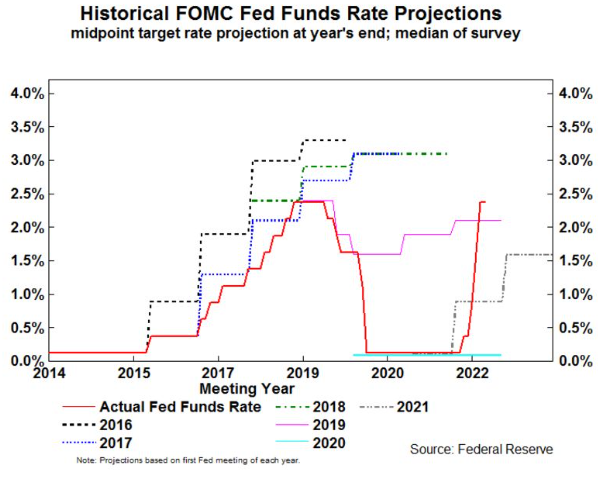The Federal Reserve’s forward guidance program has been a disaster, so much so that it has strained the central bank’s credibility. Chair Jerome Powell seems to agree that providing estimates of where the Fed sees interest rates, economic growth and inflation at different points in the future should be junked. “We think it’s time to just go to a meeting-by-meeting basis, and not provide the kind of clear guidance we had provided,” he said after the Fed’s July 26-27 monetary policy meeting.
When it began providing forward guidance almost 14 years ago, the Fed hoped that by making clear its intentions through its Quarterly Summary of Economic Projections and press conferences, it could avoid disruptive market shocks and reduce volatility. The financial meltdown of 2008 had revealed the opaqueness of the old system and the need for transparency. The central bank succumbed to the transparency pressures and in December 2008 began the use of forward guidance when it cut its overnight federal funds policy rate to near-zero and said it “will employ all available tools to promote the resumption of sustainable economic growth and to preserve price stability. In particular, the [Federal Open Market] Committee anticipates that weak economic conditions are likely to warrant exceptionally low levels of the federal funds rate for some time.”
The basic problem with forward guidance is that it depends on data that the Fed had a miserable record of forecasting. It was consistently too optimistic about an economic recovery after the 2007-2009 Great Recession. In September 2014, policy makers forecast real gross domestic product growth in 2015 of 3.40% but were forced to constantly crank their expectations down to 2.10% by September 2015.
The federal funds rate is not a market-determined interest rate but is set and controlled by the Fed, and nobody challenges the central bank. Yet the FOMC members were infamously terrible at forecasting what they themselves would do, as seen in the so-called dot plot of individual FOMC members’ rate projections shown in the chart. In 2015, their average projection of the 2016 federal funds rate was 0.90% and 3.30% in 2019. The actual numbers were 0.38% and 2.38%.

Not only has forward guidance been a failure, but it may have increased, not reduced, financial market volatility. The Fed raised rates in February 1994 without warning and in six months doubled the federal funds rate from 3% to 6% in November. That disrupted markets and caused U.S. Treasury yields to skyrocket in what became known as “The Great Bond Massacre of 1994.” The yield on the 10-year Treasury note jumped an unprecedented 2.3 percentage points from February to November of that year. The Chicago Board Options Exchange Volatility Index, or VIX, tracking the stock market spiked from 10.8 to 23.9 in April.
Despite the Fed’s credit-tightening without warning, the volatility in financial markets in 1994 was subdued, compared with recent experience. Measured by taking the 20-day moving average of the daily percentage change in yields, regardless of positive or negative, the average volatility in 10-year Treasuries in 1994 was 0.12%. The average volatility for the S&P 500 Index was negative 0.01% and the VIX Index for 1994 averaged 13.9.
To be sure, many current events today have caused uncertainty in markets, but the Fed has been in there hot and heavy with its forward guidance. Recall that early this year the central bank believed that inflation caused by frictions in reopening the economy after the pandemic and supply-chain disruptions was temporary. Only belatedly did it reverse gears, raise rates and signal that further substantial hikes are coming. Faulty Fed forecasts resulted in faulty forward guidance and increased financial market volatility.
Consequently, volatility in markets is much greater than in 1994, before the central bank broadcast its plans. Using my same measure of volatility, this year to date it has averaged 0.46% for the 10-year Treasury note. The S&P 500’s volatility is also a larger number, negative 0.09%, and the VIX has averaged 25.8.
So, financial markets without forward guidance may be calmer. As Fed Chair, Powell carries tremendous weight at the central bank and I think his suggestion to terminate forward guidance will prevail.
Gary Shilling is president of A. Gary Shilling & Co., a consultancy. He is author, most recently, of The Age of Deleveraging: Investment Strategies for a Decade of Slow Growth and Deflation, and he may have a stake in the areas he writes about.